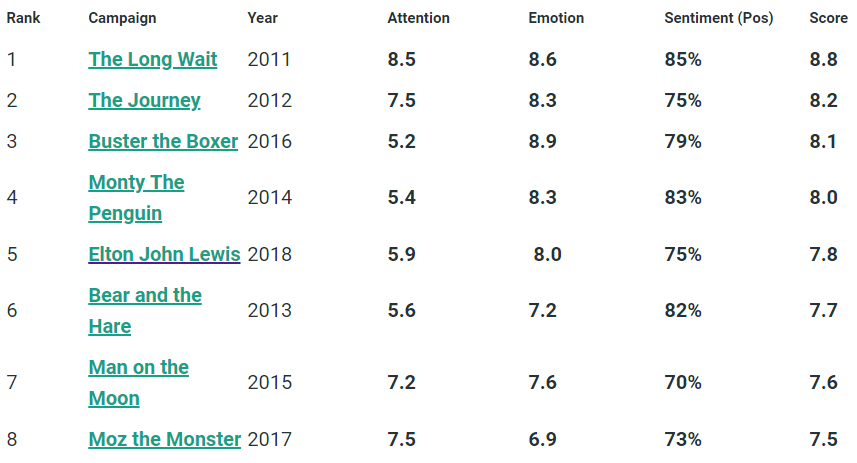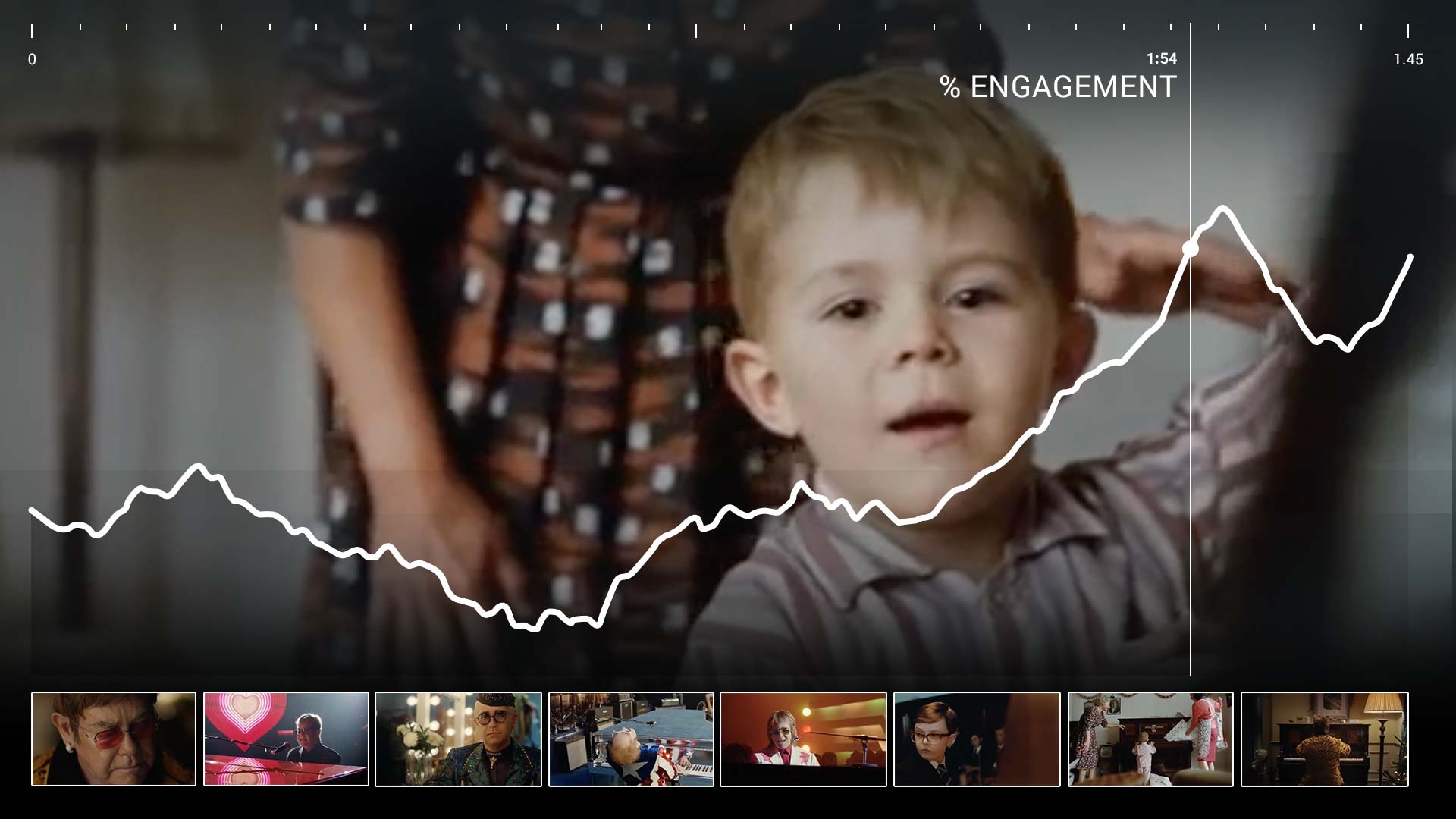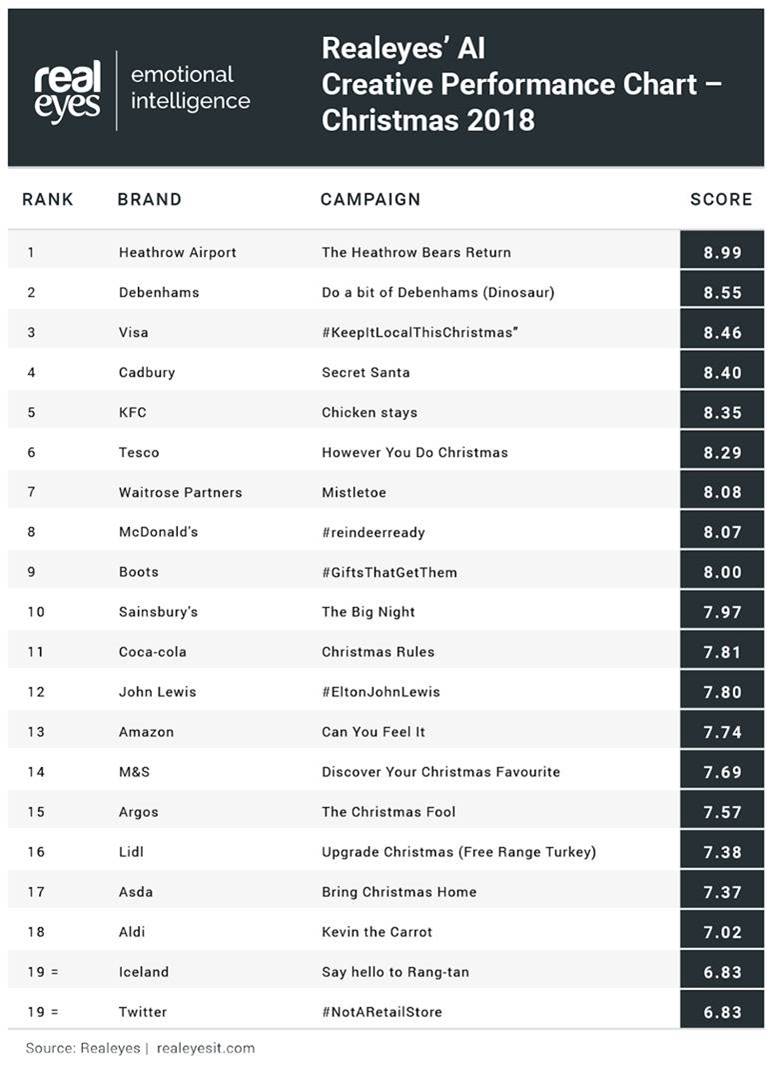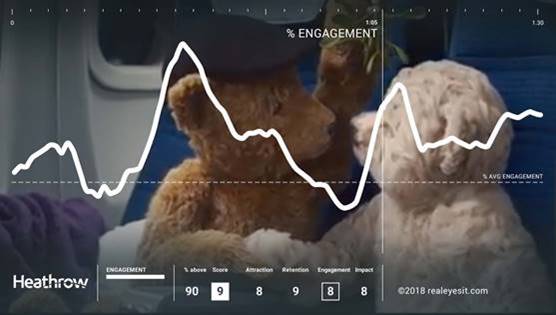Unlike their American cousins, who generally wait until Black Friday to launch their Christmas ad campaigns, the Brits start right after Halloween.
Why?
Because they don’t celebrate Thanksgiving over in the UK. So, there is no reason to wait before launching Christmas ads that trigger intense emotions like happiness and warmth, with an occasional hint of inspiration and nostalgia.
This enables savvy marketers in the States to see what resonates on the other side of the pond – and to make a few last-minute adjustments to their own campaigns.
Unfortunately, this year’s crop of Christmas ads in “old Blighty” has been described by Neil Cook, TCC Global’s global creative director, as “disappointingly anonymous” as “unimaginative shop windows.”
Or, it could be a sign of the challenging retail landscape on High Street in the U.K., which is being battered by wave upon wave of online competition from Amazon.
Or, it may simply signal regret by some agency executives that the “vanity TV project” of yesteryear has been replaced at Marks & Spencer by an “unashamedly commercial” digital-first approach.
Well, industry observers are entitled to their own opinions, but they are not entitled to their own facts.
So, Yanks will need to dig deeper this year to discover critical data and strategic insights about what is – and isn’t – happening to Christmas ads in unmerry old England.
John Lewis Decided to ‘Turn Left’ This Year
Everyone seems to have gotten their knickers in a twist when John Lewis, a chain of high-end department stores operating throughout the United Kingdom, decided to “turn left” this year when creating its annual Christmas ad campaign.
This pivot was triggered after the retailer’s 2017 Christmas ad, “#MozTheMonster,” underperformed previous campaigns, including:
Craig Inglis, John Lewis’ customer director, recently told Ellen Hammett of Marketing Week:
“It’s true to say in terms of some of the resonance and brand sentiment (#MozTheMonster) wasn’t quite at the same level we had seen before… It just felt like a point to slightly turn left and have a fresh take on Christmas and at the same time stay true to the brand.”
That’s why the retailer gave its long-standing agency adam&eveDDB the brief to come up with a fresh and different take on “thoughtful gifting” and going the extra mile.
The result was launched on November 14 – a 2-minute and 20-second long video ad with the title, “John Lewis & Partners Christmas Ad 2018 – #EltonJohnLewis.”
The video’s description calls it, “The Boy and The Piano.”
‘The Boy and the Piano’ Is 5th Most Engaging of John Lewis’ Christmas Ads
So, how did John Lewis’ 2018 Christmas ad do?
Well, it depends on how you measure success.
For example, John Lewis’ 2018 Christmas ad, “The Boy and The Piano”, which features Elton John, is more engaging than three previous campaigns from the retailer, but is less engaging than four others – if you measure success in terms of how much attention, emotional engagement, and positive sentiment a Christmas ad generates from viewers.
According to Realeyes, which used its artificial emotional intelligence technology to rank the eight John Lewis’ Christmas ads that have been published since 2011, the heartfelt biopic of the “Rocket Man” got an overall score of 7.8 out of 10, placing it fifth in emotional engagement and continuous attention from viewers.
It also generated the fifth highest proportion of positive comments (75 percent), driven mainly by the choice of soundtrack (“Your Song”).
On the other hand, 18 percent of the comments were negative, with British consumers particularly critical of John Lewis’s use of a big celebrity.

Plus, the first two-thirds of the Christmas ad, which reflect on Elton John’s illustrious career, covers well-traveled ground.
It’s the childhood scenes towards the last third of the ad that really resonate with audience emotions.

Realeyes, which uses its AI technology to help brands like Coca-Cola and Mars maximize the impact of their video marketing, also found that “The Boy And The Piano” was a huge hit among women, but it failed to generate sufficient emotional engagement overall to take the Christmas crown, which is still held by John Lewis’ 2011 campaign, “The Long Wait.”
“The Long Wait”, which features a young boy counting down the days until Christmas morning, was the star on the top of the Christmas tree after scoring 8.8 out of 10 for overall effectiveness.
The Christmas ad also finished at the top with the highest quality of continuous attention throughout the 1-minute, 31-second long ad, and the second most emotional engagement. It also attracted the highest percentage of positive comments from viewers (85 percent).
In second place was John Lewis’ 2012 campaign, “The Journey,” which has a score of 8.2.
The 2016 Christmas ad, “#BusterTheBoxer,” which features a trampolining dog, bounced its way into third with a score of 8.1.
And the retail store’s 2014 campaign, “#MontyThePenguin,” was fourth with an overall score of 8.0.
According to Realeyes, the John Lewis Christmas ads which attracted the least emotional engagement, attention and positive comments from viewers were:
Heathrow’s Teddy Bear Campaign Crowned Winner of 2018 Christmas Ads Battle
It’s one thing to be beaten by some of your own previous Christmas ads.
But, it’s like getting a lump of coal in your Christmas stocking to discover that you’ve also been eaten by the majority of your competitors this holiday season.

According to a second study by Realeyes of 20 Christmas ads by British brands, Heathrow Airport’s campaign, which is entitled, “Official Heathrow 2018 Christmas Advert – The Heathrow Bears Return | #HeathrowBears,” is the most engaging Christmas ad of 2018.
“The Heathrow Bears Return” was not only the most emotionally engaging among this year’s festive crop, but it also attracted the highest percentage of positive comments (87 percent).
The airport’s one-minute and 35-second long video, which is the latest installment in the incredibly successful “#HeathrowBears” campaign that started in 2016, attracted an overall score of 8.99 out of 10.
This put it ahead of Debenhams’ “Do A Bit Of Debenhams (Dinosaur)”, which was in second place with an overall score of 8.55.
Visa’s “#KeepItLocalThisChristmas” was third with an overall score of 8.46, while Cadbury’s “Secret Santa” (8.40) was fourth, and KFC’s “Chicken stays” ad (8.35) made it into fifth place.

It’s worth noting that John Lewis’ “#EltonJohnLewis” did not make the top 10 – ranking 13th with an overall score of 7.80.
Methodology
Realeyes tested each one of John Lewis’s Christmas ads from 2011 to 2018 on a sample audience of 300 people using its face-reading AI technology, which uses webcams to measure consumers’ attention levels and their emotional engagement while watching a video.
Realeyes also tested 20 Christmas 2018 ads on a sample audience of 200 UK consumers representing the general population. In both tests, viewers were also asked for their opinions on the creative.
Ad rankings are based on the following four scores:
- EmotionAll score: A 1-10 performance score which compares videos’ emotional engagement across Realeyes’ database of previously-tested videos.
- Attention quality: The proportion of the video which respondents, on average, managed to keep continuously attentive for.
- Attention volume: The average volume of attention respondents paid to the content.
- Sentiment: Currently in beta, this feature reveals the % breakdown of written responses by sentiment (positive, negative and neutral).
These scores were then fed into an algorithm to determine an overall score out of 10.
The higher the score, the better the ad was at grabbing attention, eliciting strong emotional responses, and stimulating positive sentiment in its audiences.
Realeyes has more than 15,000 ads in its database, of which the average score is 5 out of 10.
Waitrose’s Christmas Ad Mocks ‘The Boy and the Piano’: ‘I Prefer the One with the Penguin’
Finally, you know you’ve turned in the wrong direction when your sister pokes fun at your Christmas ad.
That is exactly what happened in “Christmas 2018 Ad | Fast Forward | Waitrose & Partners,” which was published November, 18 by Waitrose & Partners, a chain of British supermarkets, which forms the food retail division of the John Lewis Partnership.
We see a girl showing her parents “The Boy and The Piano,” but rather than taking their time to appreciate it, they seem to want to get through it as quickly as possible so they can get out of the living room and into the dining room to eat a piece of their Waitrose 1 Dark Chocolate Orange Stollen Wreath.
The mother says, “I love their art.” The father says, “It’s so emotional.”
The mother adds, “Get me every time.” And the father adds, “I prefer the one with the penguin.”
What Lessons Can Yanks & Brits Learn from John Lewis’ 2018 Christmas Ad
So, what are the lessons that Yanks – and Brits – can learn from John Lewis’ left turn?
Frankly, I wouldn’t say that this year’s crop of Christmas ads in “old Blighty” is as “disappointingly anonymous” as “unimaginative shop windows.”
Just watch the one from Heathrow Airport to see one that excels in grabbing attention, eliciting strong emotional responses, and stimulating positive sentiment in its audiences.
Now, the retail landscape on high street in the U.K. is probably more challenging than it once was. But, Amazon’s “Can You Feel It” campaign ranked below John’s Lewis’ “EltonJohnLewis” in Realeyes’ AI Creative Performance Chart for Christmas 2018.
Ranked 12th, John Lewis had a score of 7.80. Ranked 13th, Amazon had a score of 7.74.
And, I have no doubt that some agency executives regret that the “vanity TV project” of yesteryear has been replaced by what Marks & Spencer called its “unashamedly commercial” digital-first approach.
But, check the chart and you’ll see that “M&S FOOD | Christmas Advert 2018 | Discover your M&S Christmas favourite” ranks 14th with a score of 7.69, behind John Lewis and Amazon.
So, I think there are three different lessons to learn:
1. Christmas Ads Should Be About Christmas
It shouldn’t be about the monster under the bed, which probably explains why “#MozTheMonster” underperformed all of the other John Lewis Christmas ads uploaded since 2011.
And waiting until the last third of “#EltonJohnLewis” to feature the childhood scenes that really resonate with audience emotions probably explains why this Christmas ad got okay, but not great ratings.
2. Christmas Ads Should Trigger Intense Emotions
Like happiness and warmth. And an occasional hint of inspiration and nostalgia.
If you need examples, then go back and watch “The Long Wait” and “The Heathrow Bears Return.” If you stray from this formula with a celebrity biopic or an “unashamedly commercial” approach, then you will pay the price.
3. It’s Perfectly OK if Your Sister Division Pokes Fun at Your Christmas Ad
But, two can play this game.
Figure out why “Christmas 2018 Ad | Mistletoe | Waitrose & Partners” ranked seventh this year with a score of 8.08 and then poke your sister division back.
For example, create a response video that features a sibling telling a rival, “He wouldn’t hesitate under the mistletoe with one of The Meringue Girls.”
More Resources:
Image Credits
All screenshots taken by author, November 2018
Subscribe to SEJ
Get our daily newsletter from SEJ’s Founder Loren Baker about the latest news in the industry!
